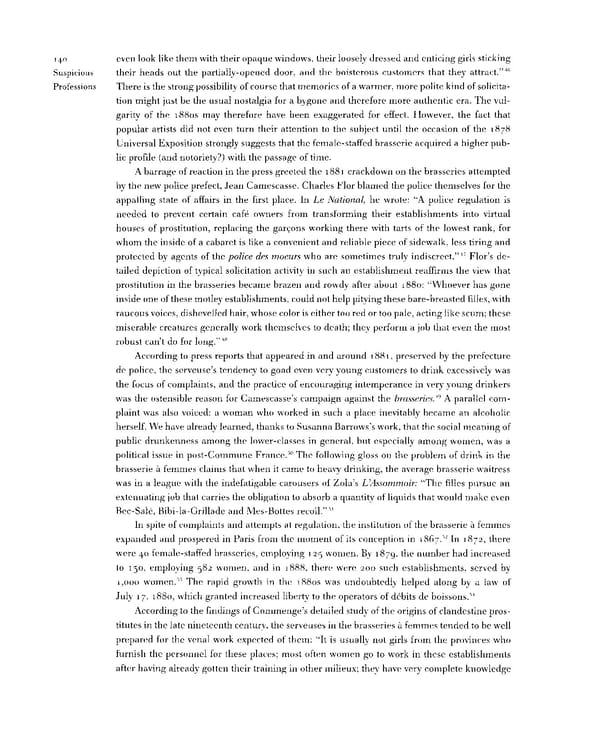140 even look like them with their opaque windows, their loosely dressed and enticing girls sticking Suspicious their heads out the partially-opened door, and the boisterous customers that they attract."46 Professions There is the strong possibility of course that memories of a warmer, more polite kind of solicita- tion might just be the usual nostalgia for a bygone and therefore more authentic era. The vul- garity of the i88os may therefore have been exaggerated for effect. However, the fact that popular artists did not even turn their attention to the subject until the occasion of the 1878 Universal Exposition strongly suggests that the female-staffed brasserie acquired a higher pub- lic profile (and notoriety?) with the passage of time. A barrage of reaction in the press greeted the 1881 crackdown on the brasseries attempted by the new police prefect, Jean Camescasse. Charles Flor blamed the police themselves for the appalling state of affairs in the first place. In Le National, he wrote: "A police regulation is needed to prevent certain cafe owners from transforming their establishments into virtual houses of prostitution, replacing the garcons working there with tarts of the lowest rank, for whom the inside of a cabaret is like a convenient and reliable piece of sidewalk, less tiring and protected by agents of the police des moeurs who are sometimes truly indiscreet."47 Flor's de- tailed depiction of typical solicitation activity in such an establishment reaffirms the view that prostitution in the brasseries became brazen and rowdy after about 1880: "Whoever has gone inside one of these motley establishments, could not help pitying these bare-breasted filles, with raucous voices, dishevelled hair, whose color is either too red or too pale, acting like scum; these miserable creatures generally work themselves to death; they perform a job that even the most robust can't do for long."48 According to press reports that appeared in and around 1881, preserved by the prefecture de police, the serveuse's tendency to goad even very young customers to drink excessively was the focus of complaints, and the practice of encouraging intemperance in very young drinkers was the ostensible reason for Camescasse's campaign against the brasseries.49 A parallel com- plaint was also voiced: a woman who worked in such a place inevitably became an alcoholic herself. We have already learned, thanks to Susanna Barrows's work, that the social meaning of public drunkenness among the lower-classes in general, but especially among women, was a 50 political issue in post-Commune France. The following gloss on the problem of drink in the brasserie a femmes claims that when it came to heavy drinking, the average brasserie waitress was in a league with the indefatigable carousers of Zola's UAssommoir: "The filles pursue an extenuating job that carries the obligation to absorb a quantity of liquids that would make even 51 Bee-Sale, Bibi-la-Grillade and Mes-Bottes recoil." In spite of complaints and attempts at regulation, the institution of the brasserie a femmes 52 expanded and prospered in Paris from the moment of its conception in iSG/. In 1872, there were 40 female-staffed brasseries, employing 125 women. By 1879, me number had increased to 130, employing 582 women, and in 1888, there were 200 such establishments, served by 05 1,000 women. The rapid growth in the i88os was undoubtedly helped along by a law of July 17, 1880, which granted increased liberty to the operators of debits de boissons.54 According to the findings of Commenge's detailed study of the origins of clandestine pros- titutes in the late nineteenth century, the serveuses in the brasseries a femmes tended to be well prepared for the venal work expected of them: "It is usually not girls from the provinces who furnish the personnel for these places; most often women go to work in these establishments after having already gotten their training in other milieux; they have very complete knowledge
 Prostitution & Impressionists Page 160 Page 162
Prostitution & Impressionists Page 160 Page 162